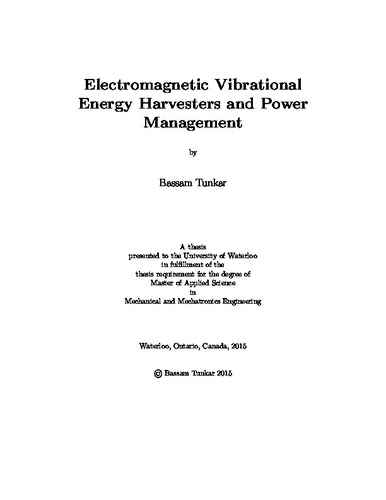| dc.contributor.author | Tunkar, Bassam | |
| dc.date.accessioned | 2016-01-14 18:49:00 (GMT) | |
| dc.date.available | 2016-01-14 18:49:00 (GMT) | |
| dc.date.issued | 2016-01-14 | |
| dc.date.submitted | 2015-12-10 | |
| dc.identifier.uri | http://hdl.handle.net/10012/10131 | |
| dc.description.abstract | The interest in scavenging various energy sources from the environment is rapidly
increasing. Thanks to the advances in developing effective energy harvesters researches.
Kinetic energy is a renewable source and it can be found numerously in
the environment. One of the most popular class of the kinetic energy harvesters
in this field is vibration energy harvesters (VEH). It is an electrical source that
converts the vibrational energy into usable electrical energy to power up low-power
portable or unreachable devices. The harvesting system can be self-powered as
stand-alone or as alternative power source depending on the application.
In this thesis, we have studied and developed two architectures for electromagnetic
VEHs: a baseline VEH and a springless VEH. We introduced and studied
power management circuits consisting of a full-wave bridge rectifier and a smoothing
capacitor. Moreover, electromechanical model was developed and validated by
the comparison to the experimental data.
The basic electromagnetic VEH uses a mechanical mass-damper-spring oscillator
to capture kinetic energy from vibrations. It has an electrical transducer using
induction between a moving coil and a fixed magnets. It uses a cantilever suspension
and operates at a frequency range of 57-59 Hz. We re-designed it using 80
turns coil-chip instead of 30-turns. The springless VEH works in a frequency range
of 13-18 Hz. It was redesigned to carry 60-turns coil-chip. The re-design of the
VEHs successfully increased the output voltage and power. The maximum power
experimentally measured were 14.3mW and 12.27mW at optimal loads RL of 40 ohm and 3 ohm, respectively.
The power management circuits introduced is consist of a MOSFET-based full-wave
bridge rectifier and a smoothing capacitor to convert the VEH AC output
waveform into a DC signal. We found that this rectifier can effectively convert
the VEHs output with high voltage and power efficiencies > 93 %. The smoothing
capacitor trades-in the signal ripples for lower voltage and power e efficiencies > 79 %.
We identified the model parameters for the cantilever VEH, namely the natural
frequency, mechanical Qm and total Qt quality factors, and effective average
magnetic field density B. We solved the model equations numerically and analytically
to find the eigenvalues, frequency response, output voltage and power. The
model results agree with the obtained experimental results. | en |
| dc.language.iso | en | en |
| dc.publisher | University of Waterloo | en |
| dc.subject | Ultra-low power rectification circuit | en |
| dc.subject | Low frequency energy harvester | en |
| dc.subject | Electromagnetic energy harvester | en |
| dc.subject | Harvester modeling | en |
| dc.title | Electromagnetic Vibrational Energy Harvesters and Power Management | en |
| dc.type | Master Thesis | en |
| dc.pending | false | |
| uws-etd.degree.department | Mechanical and Mechatronics Engineering | en |
| uws-etd.degree.discipline | Mechanical Engineering | en |
| uws-etd.degree.grantor | University of Waterloo | en |
| uws-etd.degree | Master of Applied Science | en |
| uws.contributor.advisor | Yavuz, Mustafa | |
| uws.contributor.advisor | Abdel-Rahman, Eihab | |
| uws.contributor.affiliation1 | Faculty of Engineering | en |
| uws.published.city | Waterloo | en |
| uws.published.country | Canada | en |
| uws.published.province | Ontario | en |
| uws.typeOfResource | Text | en |
| uws.peerReviewStatus | Unreviewed | en |
| uws.scholarLevel | Graduate | en |

